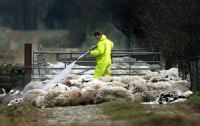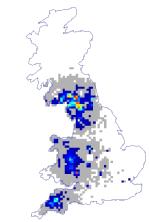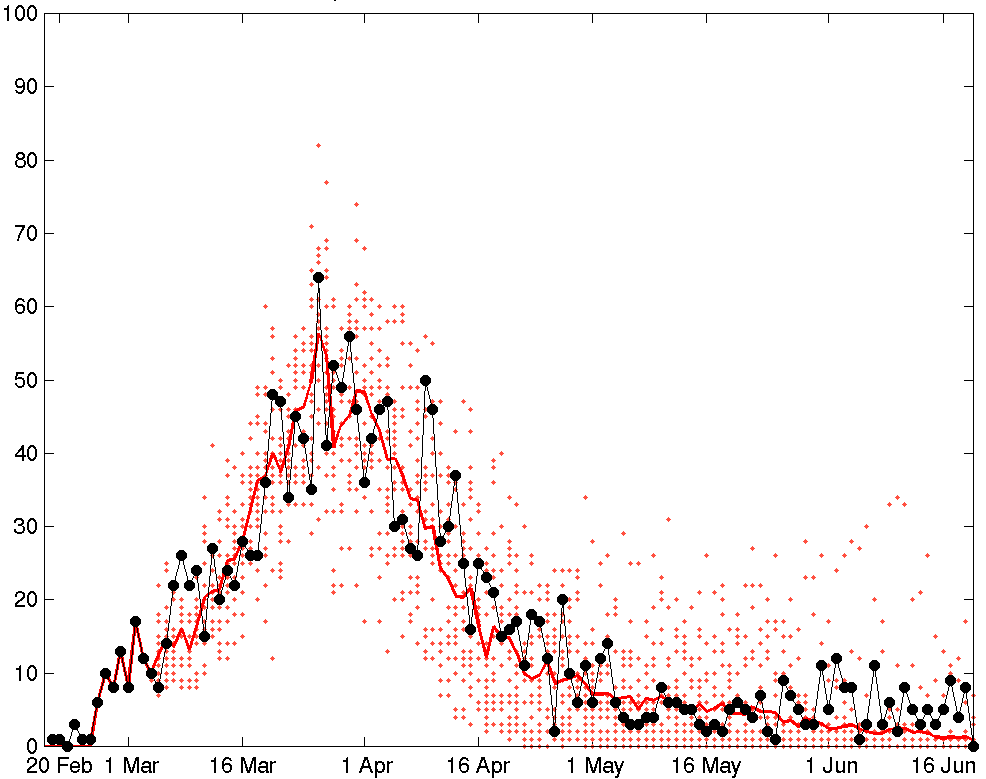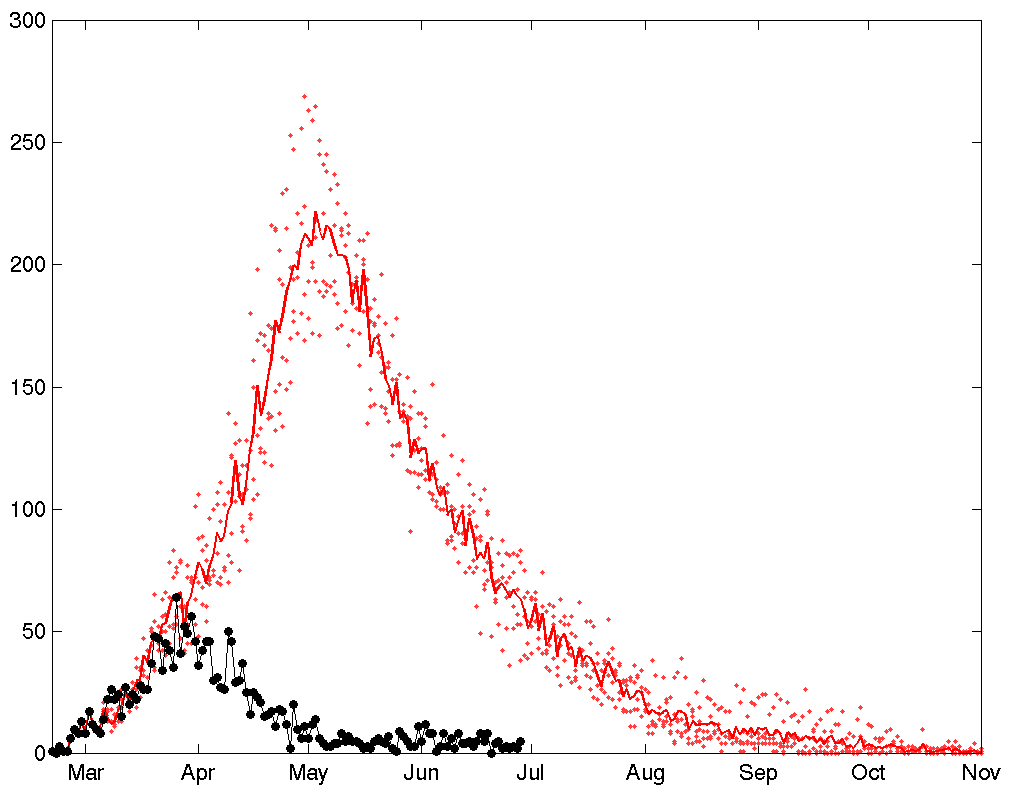Impact: Foot-and-Mouth disease
The 2001 Epidemic
Early work into the prediction of foot-and-mouth disease began in 2001 during the UK outbreak. Matt Keeling was part of one of the teams that provided a range of advice to defra based on both a statistical interpretation of the data and the development of predictive models. This was probably the first occassion when real-time modelling was used as an aid to policy. Foot and Mouth Disease is one of the most highly transmissible of any livestock disease and therefore the outbreak in 2001 had the potential to catastrophically impact on both the farming community but also the national economy. It was therefore national policy (and EU law) that infected farms should have all their animals destroyed (culled) as should all "Dangerous Contacts" where there is suspicion that the infection may have been transmitted.
It was abundantly clear from preliminary analysis that early control measures were not sufficiently effective in reducing the spread infection and therefore action was required. This took two forms: firstly, culls of infected premises and dangerous contacts, therefore removing potential sources of infection as early as possible; secondly, it was decided that due to the high risk of local transmission of the virus all farms that were continuous to an infected farm should also have their livestock culled -- this was the contravertial (but highly effective) continuous premise cull.
By the end of October 2001, nearly five million animals on ten thousand farms had been culled either as a direct result of infection or in an attempt to control the spread. Our models show that the situation could have been far worse; if only livestock on infected premises were culled then more than three times as many farms would have been affected. However, the situation could have been far better, if culls had been preformed rapidly from the start and the CP culling policy introduced earlier then we predict that the impact would only have been reduce to a quarter of that observed.
|
Foot and Mouth had a devastating impact on the farming and rural communities. It was therefore vitally important that policy decisions were aided by the best scientific advice we were able to provide. While mathematical modelling is able to provide an intergrated population-level view of control, it is only through the use of specialists on the ground that these can be implemented effectively. |
Our predictions of the scale of the outbreak based on the early location of cases. We clearly identify the main hot-spots of infection. |
Our predictions of the time-course of the outbreak (red) compared to the observed cases (black). It is clear that our model captures the main features of the epidemic and the action of increased controls in April. |
Predicted scale of the 2001 outbreak if only livestock on infected farms were culled. Only dangerous-control and contiguous-premise culls run the risk of killing un-infected animals, the national-scale impact of leaving these animals is a much larger and longer outbreak. |
After 2001
Since 2001 our modelling and statistical analysis has continued with three main themes: better statistical inference and analysis; optimal control by vaccination and spatially specific controls; and extending the approach to other countries.
In 2001, in the heat of the epidemic, the parameter inference was somewhat ad-hoc -- the main aim was to generate useful predictions, not to be too fussy about the statistical methodology. Since 2001, we have re-analysed the methods that were used during the epidemic and compared the accuracy of our models to the data on a farm-by-farm basis. In addition, we have been developing Bayesian MCMC methodology which provides a more rigorous assessment of model parameter values, but also allow us to assess the risk (on a day-by-day basis) of each farm being infected but not yet detected (so-called occult infections). Knowledge of occult infections is a vital step in efficient targeting of surveillance -- this methodology was formulated to aid with the 2007 outbreak in Surrey.
Vaccination obviously has the potential to be a powerful tool in the control of any infection. It was not used in 2001 due to difficulties of distinguishing between infected carriers of foot-and-mouth disease and animals that had been vaccinated, but modern vaccinology tools have overcome this issue. However, one of the major challenges is the delay between injecting the animal and them becoming protected against infection. In 2003 & 2006, we therefore focussed in detail on the advantages and disadvantages of vaccinating cattle (vaccinating sheep is not considered cost effective); we showed that a national rapidly implemented prophylactic vaccination campaign could be a viable control measure, and that vaccinating farms in the vacinity of recently detected infections was also highly effective.
Foot-and-Mouth outside the UK
More recent work has focused on extending this work to Denmark and the USA. Denmark presents interesting challenges and opportunities as they have comparible quality data to the UK (recording farm locations and animal numbers in each farm), but their livestock industry is dominated by pigs. In contrast, the data in the USA is of far poorer quality, often with just the number of farms and animals in each of the 3000 counties being recorded. Despite this sparsity of data, we have shown that mathematical modelling can still be a useful tool in assessing the scale of control measures that are optimal.
Publications.
- Tildesley, M.J. Smith, G. and Keeling, M.J. (2012) Modeling the spread and control of foot-and-mouth disease in Pennsylvania following its discovery and options for control, Prev Vet Med 104, 224–239
- Carslake, D., Grant, W., Green, L.E., Cave, J., Greaves, J., Keeling, M., McEldowney, J., Weldegebriel, H. and Medley, G.F. (2011) Endemic cattle diseases: comparative epidemiology and governance. Philos. Trans. R. Soc. Lond. B 366 1975-86
- Tildesley, M.J., House, T.A., Bruhn, M.C., Curry, R.J., O'Neil, M., Allpress, J.L., Smith, G. and Keeling, M.J. (2010) Impact of spatial clustering on disease transmission and optimal control. Proc Natl Acad Sci USA 107 1041-6
- Ramirez-Villaescusa, A.M., Medley, G.F., Mason, S. and Green, L.E. (2010) Risk factors for herd breakdown with bovine tuberculosis in 148 cattle herds in the south west of England. Prev. Vet. Med. 95 224-230
- Deardon, R., Brooks, S.P., Grenfell, B.T., Keeling, M.J., Tildesley, M.J., Savill, N.J., Shaw, D.J., and Woolhouse, M.E.J. (2010) Inference for Individual-level Models of Infectious Diseases in Large Populations. Stat Sinica 20 239-261
- Jewell, C.P., Kypraios, T., Neal, P. and Roberts, G.O. (2009) Bayesian Analysis for Emerging Infectious Diseases. Bayesian Analysis. 4 465-496
- Tildesley, M.J. and Keeling, M.J. (2009) Is R0 a good predictor of epidemic size: Foot-and-Mouth disease in the UK. Theor. Biol. 75 133-141
- Jewell, C.P., Keeling, M.J. and Roberts, G.O. (2009) Predicting undetected infections during the 2007 foot-and-mouth disease outbreak. J. R. Soc. Interface. 6 1145-151
- Tildesley, M.J., Bessell, P.R., Keeling, M.J. and Woolhouse, M.E.J. (2009) The role of pre-emptive culling in the control of foot-and-mouth disease. Proc. Roy. Soc. Lond. B. 276 3239-3248.
- Tildesley, M.J. and Keeling, M.J. (2008) Modelling foot-and-mouth disease: a comparison between the UK and Denmark. Pre Vet Med. 85 107-124.
- Tildesley, M.J., Deardon, R., Savill, N.J., Bessell, P.R., Brooks, S.P., Woolhouse, M.E.J., Grenfell, B.T. and Keeling, M.J. (2008) Accuracy of models for the 2001 foot-and-mouth epidemic. Proc. Roy. Soc. Lond. B. 275 1459-1468.
- Carrique-Mas, JJ; Medley, GF; Green, LE (2008) Risks for bovine tuberculosis in British cattle farms restocked after the foot and mouth disease epidemic of 2001. Prev. Vet. Med. 84 85-93
- NJ Savill, DJ Shaw, R Deardon, MJ Tildesley, MJ Keeling, MEJ Woolhouse, SP Brooks, BT Grenfell (2007) Effect of data quality on estimates of farm infectiousness trends in the UK 2001 foot-and-mouth disease epidemic. Journal of the Royal Society Interface 4, 235-241
- MJ Tildesley, NJ Savill, DJ Shaw, R Deardon, SP Brooks, MEJ Woolhouse, BT Grenfell, MJ Keeling (2007) Veterinary epidemiology: Vaccination strategies for foot-and-mouth disease (reply). Nature 445, E12-E13
- MJ Tildesley, NJ Savill, DJ Shaw, R Deardon, SP Brooks, MEJ Woolhouse, BT Grenfell, MJ Keeling (2006) Optimal reactive vaccination strategies for a foot-and-mouth outbreak in the UK. Nature 440, 83-86
- NJ Savill, DJ Shaw, R Deardon, MJ Tildesley, MJ Keeling, MEJ Woolhouse, SP Brooks, BT Grenfell (2006) Topographic determinants of foot and mouth disease transmission in the UK 2001 epidemic. BMC Veterinary Research 2, art. no. 3
- MJ Keeling (2005). Models of Foot-and-Mouth Disease. Proc. Roy. Soc. Lond. B 272, 1195-1202.
- MJ Keeling, MEJ Woolhouse, RM May, G Davies, BT Grenfell (2003). Modelling Vaccination Strategies Against Foot-and-Mouth Disease. Nature 421, 136-142.
- Green, L.E. and Medley, G.F. (2002) Mathematical modelling of the foot and mouth disease epidemic of 2001: Strengths and weaknesses. Research in Vet. Sci. 73 201-205
- Green, L., Wood, J., Newton, R., Mellor, D., Menzies, F., Kelly, L. and Peeler, E. (2003) Modelling and FMD. Vet. Record 151 394-395
- MJ Keeling, MEJ Woolhouse, DJ Shaw, L Matthews, M Chase-Topping, DT Haydon, SJ Cornell, J Kappey, J Wilesmith, BT Grenfell (2001). Dynamics of the 2001 UK Foot and Mouth Epidemic: Stochastic Dispersal in a Heterogeneous Landscape. Science 294, 813-817.
- M Woolhouse, M Chase-Topping, D Haydon, J Friar, L Matthews, G Hughes, D Shaw, J Wilesmith, A Donaldson, S Cornell, M Keeling & B Grenfell (2001). Foot-and-mouth disease under control in the UK. Nature 414, 258-258.




